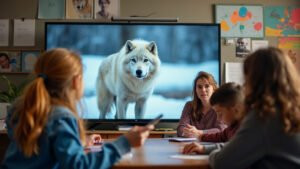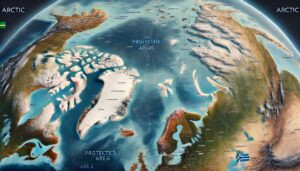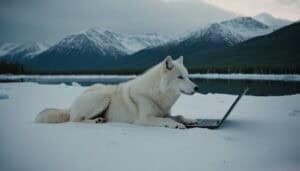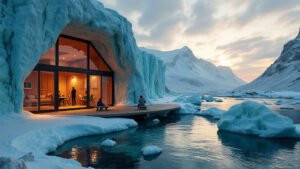Introduction
Arctic wolves, majestic creatures of the north, have captivated the attention of wildlife enthusiasts and educators alike. Documentaries about these animals offer a unique window into their lives, showcasing their survival strategies, social dynamics, and the harsh yet beautiful environment they inhabit
This article explores the best documentaries about Arctic wolves, highlighting their educational value, the key themes they cover, and the sophisticated techniques used in their creation. By delving into these films, we gain a deeper understanding of the Arctic wolf’s role in the ecosystem and the challenges they face in a rapidly changing world
Top Educational Documentaries About Arctic Wolves
Documentaries serve as powerful educational tools, bringing the distant and often harsh realities of the Arctic into the classroom or living room. When it comes to Arctic wolves, a handful of documentaries stand out for their depth, accuracy, and engaging presentation
Notable Documentaries and Their Directors
“White Wolf: The Ghost of the Arctic”
Directed by Oliver Goetzl, this documentary offers an intimate look at the life of the Arctic wolf. It follows a pack through the changing seasons, showcasing their hunting strategies, pack dynamics, and the challenges they face in the wild
Goetzl’s dedication to capturing the raw beauty and struggle of these animals has earned the film critical acclaim for both its cinematography and storytelling
“Arctic Wolf Pack”
Produced by PBS’s Nature series, “Arctic Wolf Pack” delves into the social structure and survival strategies of a pack of wolves in the Arctic. The film is notable for its detailed portrayal of the wolves’ cooperative hunting techniques and the pack’s interactions with other wildlife
The documentary’s educational value is enhanced by its clear explanations and engaging narration, making it a favorite among educators
“Frozen Planet”
This BBC series, narrated by David Attenborough, includes significant segments on Arctic wolves. The high production value and scientific accuracy of “Frozen Planet” make it an essential resource for anyone interested in understanding the broader context of the Arctic ecosystem, including the role of wolves
The series’ comprehensive approach ensures that viewers gain a well-rounded understanding of how these wolves adapt to their frigid environment
Popularity and Reception Among Educators
Educators and students have praised these documentaries for their ability to bring complex biological and ecological concepts to life
Teachers often use them to supplement lessons on animal behavior, ecosystems, and conservation. Feedback from educational forums and reviews highlights several reasons for their popularity:
Engaging Narratives: The storytelling in these documentaries is both captivating and informative, making it easier for students to grasp and retain information
Visual Appeal: The stunning visuals help maintain the interest of viewers of all ages. High-definition footage of Arctic landscapes and wildlife provides an immersive experience that textbooks cannot match
Expert Contributions: Many of these documentaries feature insights from leading scientists and researchers, adding credibility and depth to the information presented
Age-Appropriate Content
When selecting documentaries for educational purposes, it’s crucial to consider the age appropriateness of the content:
Elementary School: For younger students, documentaries like “White Wolf: The Ghost of the Arctic” are ideal due to their straightforward narration and focus on the wolves’ daily activities
Middle School: At this level, “Arctic Wolf Pack” is suitable as it delves deeper into the complexities of wolf behavior and social structure without being too advanced
High School: High school students can benefit from more comprehensive documentaries such as “Frozen Planet,” which provide a broader context of the Arctic environment and the interconnectedness of its inhabitants
Integrating Documentaries Into Curriculum
Incorporating documentaries into the curriculum can enhance learning by providing real-world examples that complement theoretical knowledge
Here are some effective strategies for integrating these films:
Pre-Viewing Activities: Engage students with discussions or worksheets about what they know about Arctic wolves and what they expect to learn
Guided Viewing: Provide students with specific questions to answer while watching the documentary, helping them focus on key concepts and details
Post-Viewing Discussions: Facilitate discussions or projects that encourage students to reflect on what they learned and how it applies to broader ecological or biological principles
Cross-Disciplinary Connections: Use the documentaries to explore themes in science, geography, and even literature, drawing connections across different subject areas
These strategies not only make the viewing experience more interactive but also reinforce the educational content, helping students retain and apply what they have learned
Key Themes and Educational Insights
Documentaries about Arctic wolves cover a range of themes and provide valuable educational insights that extend beyond simple wildlife observation. Understanding these key themes can enhance the educational impact of these films
Survival and Adaptation
Arctic wolves inhabit one of the harshest environments on Earth, where temperatures can plummet below -30 degrees Fahrenheit, and food can be scarce. Documentaries often focus on the remarkable adaptations that allow these wolves to thrive in such conditions:
Physical Adaptations: Arctic wolves have several physical traits that enable them to survive in the cold
For instance, their thick fur provides insulation against the freezing temperatures, and their white coat camouflages them against the snow, aiding in hunting. They also have shorter ears and muzzles compared to other wolf species, which minimizes heat loss
Behavioral Adaptations: These wolves exhibit unique behaviors that help them conserve energy and find food
For example, they travel in packs, which not only helps in hunting larger prey like musk oxen and caribou but also provides warmth and protection. Documentaries often highlight these hunting strategies and the social dynamics within the pack
Social Structures and Behaviors
Arctic wolves live in highly structured packs with complex social hierarchies. Understanding these social structures can provide insights into the wolves’ behavior and survival strategies:
Pack Dynamics: Each pack is led by an alpha male and female, whose leadership ensures the survival and cohesion of the group
The roles within the pack are well-defined, with subordinate wolves supporting the alpha pair. Documentaries often explore these dynamics, showing how leadership is established and maintained
Communication: Wolves communicate through a variety of vocalizations, body language, and scent markings. These methods of communication are crucial for maintaining pack cohesion, coordinating hunts, and establishing territory
“Arctic Wolf Pack” provides excellent footage of these communication methods in action, illustrating their importance in the wolves’ daily lives
By examining these social behaviors, documentaries help viewers understand the complexity of wolf packs and the importance of social bonds in their survival
Biological and Ecological Information
Documentaries on Arctic wolves are rich sources of biological and ecological information, providing viewers with a deeper understanding of the species and its role in the ecosystem:
Diet and Hunting: Arctic wolves are carnivores, primarily hunting caribou and musk oxen
Their hunting techniques are sophisticated, involving teamwork and strategy. Documentaries often showcase these hunts, explaining the nutritional needs of the wolves and the energy costs associated with hunting in such a challenging environment
Reproduction and Life Cycle: The life cycle of Arctic wolves is another key theme. Documentaries often follow the breeding season, the birth of pups, and their development within the pack. This provides a comprehensive view of the species’ reproductive strategies and parental care
Ecological Role: As apex predators, Arctic wolves play a crucial role in their ecosystem. They help control the populations of their prey, which in turn affects the vegetation and overall health of the ecosystem. “Frozen Planet” explores this interconnectedness, showing how the presence of wolves can influence the entire Arctic environment
Conservation Messages
Many documentaries also emphasize the importance of conservation and the threats faced by Arctic wolves. These films often address issues such as climate change, human encroachment, and the impact of industrial activities on the wolves’ habitat:
Climate Change: The Arctic is one of the regions most affected by climate change, with rapidly melting ice and changing weather patterns. Documentaries highlight how these changes impact Arctic wolves, from altering their hunting grounds to affecting the availability of prey
Human Impact: Human activities, such as mining and oil exploration, pose significant threats to Arctic wolf habitats. Documentaries often discuss the need for conservation efforts to protect these areas and ensure the survival of the species
Filmmaking Techniques and Visuals
Documentaries about Arctic wolves not only provide educational content but also showcase advanced filmmaking techniques that bring the harsh and beautiful Arctic landscape to life. These techniques are crucial in capturing the elusive nature of Arctic wolves and making the documentaries visually compelling
Challenges in Filming Arctic Wolves
Filming Arctic wolves presents numerous challenges due to the extreme environment and the wolves’ elusive nature. Documentaries often require extensive planning, patience, and innovative techniques to overcome these obstacles:
Harsh Weather Conditions: Filmmakers must endure freezing temperatures, strong winds, and limited daylight hours, particularly during the winter months. These conditions can be hazardous and require specialized equipment and clothing to ensure the safety and well-being of the crew
Remote Locations: Arctic wolves inhabit some of the most remote and inaccessible regions of the world. Filmmakers often have to travel long distances and set up base camps in isolated areas, which can be logistically challenging and expensive
Elusive Behavior: Arctic wolves are wary of humans and can be difficult to locate and follow. Filmmakers often rely on local guides and trackers who have extensive knowledge of the wolves’ habits and territories
Innovative Filmmaking Methods
To capture the behavior and environment of Arctic wolves effectively, filmmakers use a variety of innovative techniques and equipment:
High-Definition and Slow-Motion Cameras: High-definition cameras are essential for capturing the fine details of the Arctic landscape and the wolves’ behavior. Slow-motion footage is often used to illustrate fast-paced actions such as hunting and play, allowing viewers to appreciate the complexity and grace of these movements
Drones: Drones have revolutionized wildlife filming by providing aerial perspectives that were previously difficult or impossible to achieve. They can follow the wolves over vast distances, capturing their movements across the tundra and offering stunning views of the Arctic scenery
Remote Cameras: To observe wolves without disturbing them, filmmakers often use remote cameras placed strategically in their habitats. These cameras can be left in the field for extended periods, capturing candid and natural behaviors that might be missed by a human presence
Underwater Filming: In some documentaries, underwater cameras are used to show the interactions of wolves with their aquatic environment, such as crossing rivers or hunting fish. This adds another dimension to the visual storytelling and highlights the adaptability of Arctic wolves
Cinematography Highlights
The visual appeal of Arctic wolf documentaries is a significant factor in their educational impact and popularity. The stunning cinematography not only captivates viewers but also enhances the storytelling:
Landscape Shots: Sweeping shots of the Arctic landscape, including vast ice fields, snow-covered mountains, and frozen lakes, set the scene and convey the harshness and beauty of the wolves’ environment. These shots often serve as a backdrop for the wolves’ activities, highlighting their resilience and adaptability
Close-Up Footage: Close-up shots of wolves allow viewers to see their expressions, interactions, and physical features in detail. This intimate perspective helps to build an emotional connection between the audience and the animals, fostering a deeper appreciation for their lives and struggles
Behavioral Sequences: Detailed sequences of wolves hunting, playing, and interacting with each other provide insight into their behavior and social structures. These sequences are often accompanied by expert commentary that explains the significance of the observed behaviors
Use of Technology in Wildlife Filming
The use of cutting-edge technology is essential in creating compelling and educational wildlife documentaries. Advances in camera technology, data analysis, and post-production techniques have significantly improved the quality and impact of these films:
Thermal Imaging: Thermal cameras can capture heat signatures of animals, allowing filmmakers to observe wolves at night or in low-visibility conditions. This technology provides unique insights into nocturnal behaviors and hunting patterns
Satellite Tracking: By attaching GPS collars to some wolves, researchers and filmmakers can track their movements over long periods. This data helps to create accurate and informative narratives about the wolves’ territory, hunting grounds, and migratory patterns
3D and IMAX Filming: Some documentaries utilize 3D and IMAX technology to create immersive viewing experiences. These formats enhance the visual impact of the film, making viewers feel as if they are part of the Arctic environment and closer to the wolves themselves
Scientific Accuracy and Ecosystem Roles
Documentaries about Arctic wolves are not just visually stunning and engaging; they also provide scientifically accurate information that enhances our understanding of these animals and their ecosystem
This accuracy is critical for educational purposes, ensuring that viewers receive reliable and valuable insights
Expert Contributions and Consultations
One of the hallmarks of high-quality wildlife documentaries is the involvement of experts in their production. These professionals ensure that the content is both accurate and informative:
Biologists and Ecologists: Documentaries often feature interviews and insights from leading scientists who specialize in Arctic wildlife
Their expertise helps to explain complex behaviors and ecological interactions in an accessible way. For instance, Dr. David Mech, a renowned wolf biologist, has contributed to several documentaries, providing invaluable information on wolf behavior and ecology
Field Researchers: On-the-ground researchers who spend extensive time studying Arctic wolves contribute firsthand observations and data
Their work often forms the basis of the narrative, offering a detailed look at the daily lives and challenges of the wolves
Veterinarians and Geneticists: Experts in animal health and genetics help to explain aspects such as disease resistance, genetic diversity, and the physical adaptations of Arctic wolves. Their contributions add depth to the documentaries, linking the observable behaviors to underlying biological processes
Comparing Documentaries to Scientific Research
To ensure that the information presented in documentaries aligns with current scientific knowledge, filmmakers often compare their footage and narratives with published research:
Peer-Reviewed Studies: Documentaries like “Frozen Planet” and “White Wolf: The Ghost of the Arctic” base much of their content on peer-reviewed studies. These studies provide a rigorous scientific foundation, ensuring that the documentaries reflect the latest understanding of Arctic wolves
Long-Term Studies: Some documentaries highlight findings from long-term research projects, which provide comprehensive insights into wolf behavior, population dynamics, and ecological impact
For example, the Ellesmere Island wolf study, ongoing since 1986, has significantly contributed to our knowledge of Arctic wolves and is frequently cited in documentaries
Behavioral Observations: Field observations recorded in documentaries are often cross-referenced with existing research to confirm their accuracy. This process ensures that the behaviors shown are typical and scientifically validated
Predator-Prey Relationships
Arctic wolves play a critical role in their ecosystem as apex predators. Documentaries often explore these predator-prey relationships to illustrate the broader ecological dynamics:
Hunting Strategies: Arctic wolves primarily hunt large herbivores such as caribou and musk oxen. Documentaries showcase these hunts, detailing the strategies wolves use to track, chase, and take down their prey. This information is crucial for understanding the wolves’ role in controlling prey populations
Impact on Prey Populations: By preying on the weak and sick individuals, Arctic wolves help maintain the health of prey populations. This selective predation ensures that only the strongest animals survive, promoting genetic diversity and the overall resilience of the species
Cascade Effects: The presence of wolves can have cascading effects on the ecosystem. For example, by controlling herbivore populations, wolves indirectly influence plant communities and the overall structure of the habitat. “Frozen Planet” explores these ecological relationships, showing how the removal or reintroduction of wolves can transform entire landscapes.
Impact on Arctic Biodiversity
The role of Arctic wolves extends beyond their immediate interactions with prey; they are integral to the biodiversity of their habitat:
Scavenger Support: Wolves’ kills provide food for a variety of scavengers, including foxes, ravens, and even bears. Documentaries often depict these interactions, highlighting the interconnectedness of Arctic species
Habitat Modification: By influencing prey populations, wolves can affect vegetation patterns and the distribution of other species. This ecological engineering contributes to the overall biodiversity and stability of the Arctic ecosystem
Indicator Species: Arctic wolves are considered an indicator species, meaning their health and population trends can reflect the broader health of the Arctic environment. Monitoring wolf populations provides insights into the impacts of climate change, human activities, and other environmental pressures
Conclusion
Documentaries about Arctic wolves serve as powerful educational tools, offering a window into the lives of these magnificent creatures and the harsh environments they inhabit. Through a combination of expert insights, innovative filmmaking techniques, and stunning visuals, these films provide a comprehensive and engaging learning experience
Top Educational Documentaries About Arctic Wolves detail the most notable films and their directors, highlighting how these works are received by educators and their age-appropriate content. These documentaries make complex biological and ecological concepts accessible and engaging for students of all ages
Key Themes and Educational Insights explore the critical themes such as survival and adaptation, social structures, and conservation messages. These documentaries shed light on the intricate behaviors of Arctic wolves and their essential role in the ecosystem, offering viewers a deeper understanding of these animals and their environment
Filmmaking Techniques and Visuals reveal the challenges and innovations in capturing the elusive nature of Arctic wolves. Advanced techniques like high-definition cameras, drones, and remote cameras, along with stunning cinematography, ensure that these documentaries are both visually compelling and educational
Scientific Accuracy and Ecosystem Roles emphasize the importance of expert contributions and consultations to ensure the content is reliable and informative. Documentaries accurately depict predator-prey relationships and the broader ecological impacts of Arctic wolves, highlighting their role in maintaining biodiversity and ecological balance
These documentaries not only entertain but also educate, fostering a greater appreciation for Arctic wolves and the critical importance of their conservation. By bringing the Arctic’s beauty and challenges to a global audience, they inspire viewers to understand and protect this vital part of our natural world










